Discover the mountainous majesty of Colorado and Utah on this Denver to Salt Lake City road trip. Drive through some of the most amazing and awe-inspiring landscapes created by nature.
This Denver to Salt Lake City road trip is designed for those who love to explore the natural world. The route brings you to forests, rivers, canyons, deserts, unbelievable rock formations and more while giving you the option to make the journey as adventurous or laidback as you want. Along the way, you’ll visit both national and state parks, but you’ll start and end the trip with the opportunity to check out two urban hubs, Denver and Salt Lake City.
Stops
1. Denver
2. Glenwood Canyon
3. Black Canyon of the Gunnison National Park
4. Arches National Park
5. Goblin Valley State Park
6. Salt Lake City
Info at a glance
- 8-10 day trip
- Type of route: Nature
- 6 stops along the route
- 816 miles of driving
Highlights
- Go hiking, whitewater rafting or fly fishing near Glenwood Canyon.
- Gaze in awe at the majestic Black Canyon of the Gunnison National Forest.
- Explore the amazing landscape of Arches National Park.
- Wander through other-worldly rock formations in Goblin Valley State Park.
- Discover the culture of Salt Lake City.
Getting to the start
You’ll start the road trip in Denver, Colorado. If you’re arriving from out of state, you can fly into Denver International Airport and rent a car to use for the rest of your trip. Alternatively, you can drive into Denver on I-25 from the north or south or I-70 from the east. You can also arrive in Denver by Amtrak train.
When to Visit
The best time of year for this road trip is during late spring or early fall. Summer is also a beautiful and popular time to visit, but you will face crowds and hotter temperatures. Be prepared for lots of time outdoors and pack hiking shoes, comfortable clothes you can layer, a hat, sunscreen, swimsuit, a refillable water bottle and something to take pictures with.
Driving tips
The maximum speed limit in Colorado is 65 miles per hour, and you may find limits up to 80 mph in Utah. However, as you’ll be traveling through mountains, the driving conditions will vary, so you’ll want to adjust your speed accordingly. This road trip route doesn’t include any toll roads, but you might encounter a few around Denver. If you don’t have a toll tag, you’ll receive a bill in the mail. There’s only one short toll road in Utah, north of Salt Lake City, and you can pay in cash.
What to know about the route
On this 816-mile road trip from Denver to Salt Lake City, you’ll discover unbelievable natural sites and geologic wonders. You’ll start in Denver and spend a day or two exploring the city however you like, and then head west on I-70. After traveling through Vail, and soaking up some mountain views, you’ll arrive in Glenwood Canyon. This area offers outdoor adventures of all kinds, or you can take a relaxing soak in one of its three hot springs. Next, you’ll head to Black Canyon of the Gunnison National Park before heading into Utah and Arches National Park, and then Goblin Valley State Park. These three parks are ideal for those who love to hike and camp, and they’re also a photographer’s dream, with more amazing views than you can imagine. If you can, plan to spend an extra day or two in the Arches area so you can also explore the nearby Canyonlands National Park and Dead Horse Point State Park. You’ll end your trip in Salt Lake City. Consider renting an SUV for your road trip, especially if you plan to camp, so you’ll have room for all your gear. For longer trips, check out weekly rental cars from SIXT.
Denver
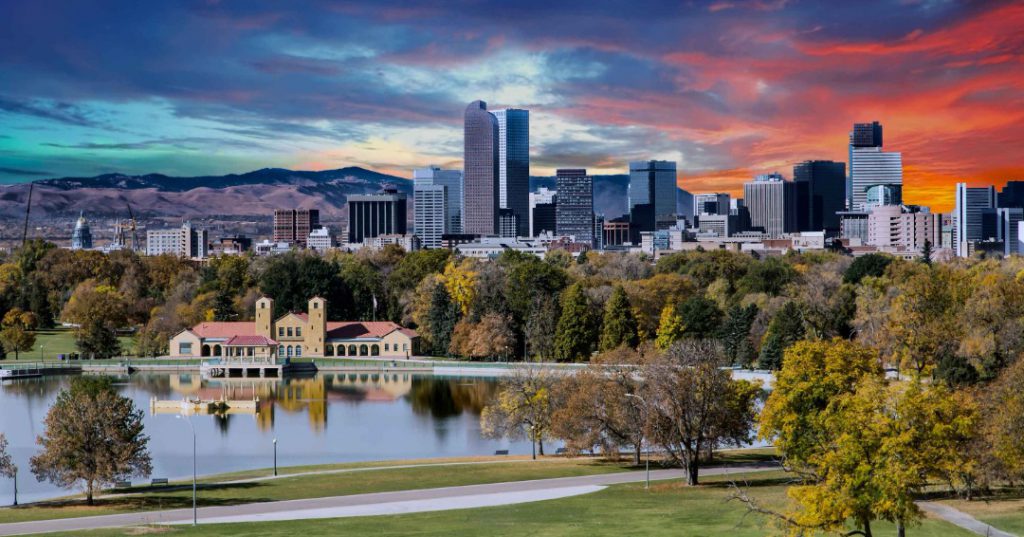
Denver, also known as the Mile High City, is easily accessible and an ideal place to start a road trip. As you’ll be spending most of the next several days in nature, take advantage of all this city has to offer by enjoying some of its cultural sites, fun shopping destinations and delicious food.
Points of interest
Check out the historic Larimer Square to shop or grab a bite to eat. Visit one of the many museums, like the Denver Art Museum or the Molly Brown House. Take a stroll through the Denver Botanic Gardens for a relaxing afternoon or visit Elitch Gardens Theme and Water Park, the only downtown theme park in America, for a bit more adventure.
Where to eat, drink and sleep
Foodies are sure to find plenty to enjoy in Denver. The LoDo (lower downtown) historic district features over 90 brewpubs, bars, restaurants, and cafes. Denver Union Station not only provides convenient bus and rail access, it’s also a dining and entertainment hub, featuring trendy restaurants and bars. For an iconic Denver steakhouse, check out the Buckhorn Exchange, the oldest restaurant in Denver, which features a variety of wild game like elk and yak along with the standard fare.
Sixt Insider Tip
Red Rocks Park & Amphitheatre is a can’t-miss site even if you don’t get to see a show. Visit the free museum or hike one of the many trails through the beautiful red rock terrain. And check out the concert schedule if you have time to squeeze one into your itinerary.
From Denver to Glenwood Canyon (155 miles)
You’re headed to Glenwood Canyon next, heading west out of Denver on I-70. You’ll want to savor every moment of the drive, experiencing the majestic mountains, forests and beautiful scenery along the way. Your route will pass right through Vail, if you’d like to stop for a bite to eat or simply to check out the famous ski town with its Bavarian-inspired architecture.
Glenwood Canyon
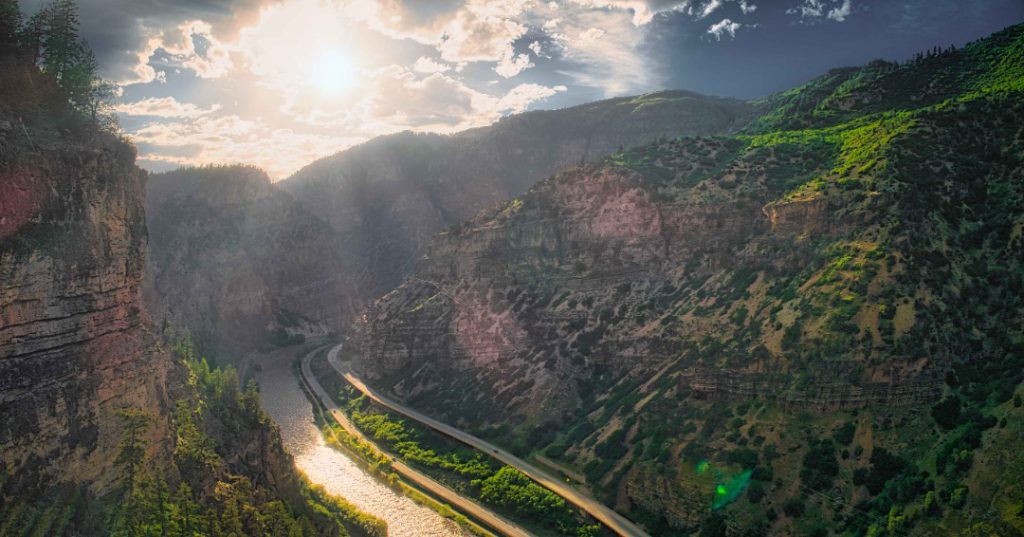
Glenwood Canyon in Glenwood Springs, Colorado, is a 16-mile canyon carved by the Colorado River. You’ll find plenty of opportunities for recreation in the area, including hiking, whitewater river rafting, kayaking, fishing, biking and more. The area is both a geologic and engineering marvel, featuring 40 bridges and two 4,000-ft-long tunnels, along with natural beauty and wildlife to discover.
Points of interest
Those who love to explore the outdoors will want to check out any of the numerous hiking trails in Glenwood Springs and the nearby White River National Forest. For those looking to relax, the area features three different hot springs spa destinations you can visit: Glenwood Hot Springs Resort, Iron Mountain Hot Springs and Yampah Spa and Vapor Caves.
Sixt Insider Tip
The rivers, springs and lakes in the Glenwood Springs area are well-known for their world-class fly fishing, which is popular and easily accessible year-round. You’ll find browns, brookies, cutthroats and rainbow trout along with plenty of local fly-fishing outfitters to guide you and supply equipment. Both beginners and experienced fly fishers alike will find a trip to suit their needs.
From Glenwood Canyon to Black Canyon (158 miles)
Next, you’ll drive to the Black Canyon of Gunnison National Park. You’ll start this portion of the drive by continuing on I-70 West, and then finish on US-50 E to arrive at the South Rim of the national park. You’ll get to enjoy the gorgeous scenery of Colorado along the route.
Black Canyon of the Gunnison National Park
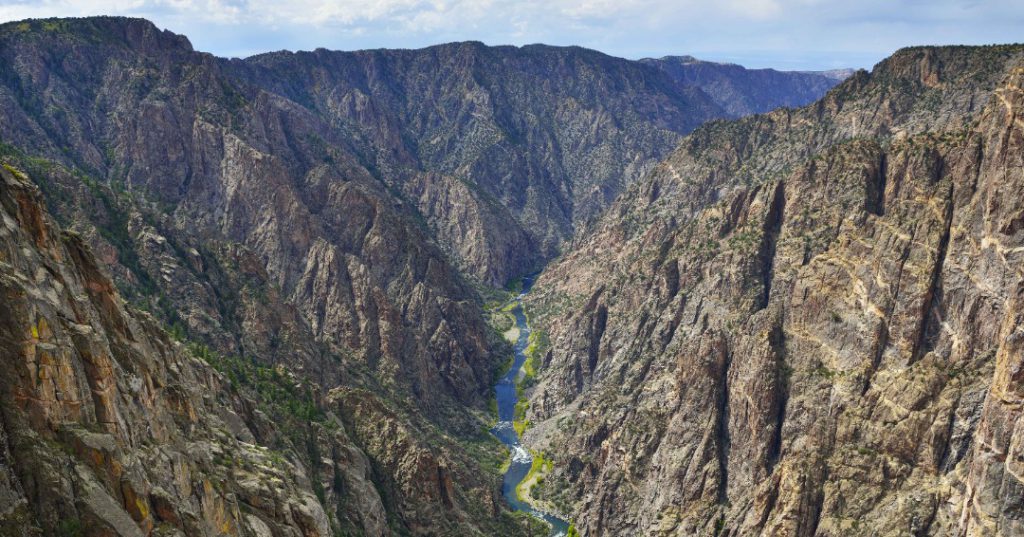
Black Canyon of the Gunnison National Park covers 12 miles of the deepest and most dramatic part of the 48-mile-long Black Canyon, which is so named for the limited amounts of sunlight certain portions of the canyon receive each day. It offers breathtaking views of sheer cliffs, hiking trails for all levels, amazing dark sky viewing, and the opportunity to visit one of the lesser-known national parks.
Points of interest
You can choose to visit the Black Canyon via either the South or North Rim. There is no bridge between the two rims, so you’ll need to allow two to three hours to drive between the two sides if you’d like to visit them both. The South Rim has more services and overlooks, along with a better view of the Painted Wall, while the North Rim offers better views into the narrowest part of the canyon and requires traveling on a gravel road.
Where to eat, drink and sleep
The park offers two campgrounds, one on each rim, and other private and public campgrounds are also available in the area. The park doesn’t offer any other lodging options. You’ll find the closest hotels and restaurants in Montrose. Consider stopping at a grocery store in Montrose to stock up on food before heading into the park.
Sixt Insider Tip
You’ll find 12 overlook stops along the 7-mile South Rim Road. Some of these are right next to the road, and others require a short walk. If you can’t stop at them all, make sure you don’t miss Gunnison Point, Chasm View, Painted Wall, Sunset View and Pulpit Rock.
From Black Canyon to Arches National Park (184 miles)
Our next stop along this scenic road trip is Arches National Park. You’ll leave the Black Canyon the same way you arrived, along US-50 W, and rejoin I-70 W. You’ll cross into Utah and then take US-191 S into the park, just before Moab, Utah. Consider stopping for food and gas near where you rejoin I-70, as you might not find as many amenities on the stretch of road after you cross the Utah border.
Arches National Park
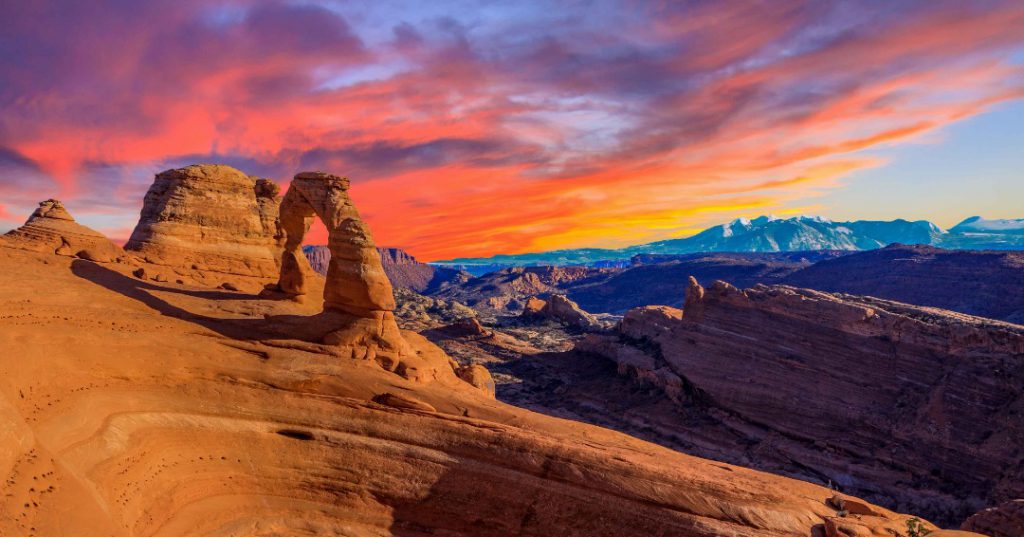
Arches National Park features thousands of natural stone arches as well as a multitude of other amazing rock formations, including pinnacles and balanced rocks. When visiting the park, expect to do lots of hiking and take even more pictures. Expect crowds and try to arrive either before 8:00 a.m. or later in the afternoon to avoid entrance delays and traffic.
Points of interest
Hiking is the best way to get up close to the natural geologic beauty of the park, and options exist for all levels, but you can also see many of the famous arches via a scenic drive and short stops at each viewpoint. Can’t-miss sites include The Windows, Delicate Arch and Balanced Rock.
Where to eat, drink and sleep
Nearby Moab offers a variety of options to meet your lodging, dining and shopping needs. The campgrounds in Arches fill up quickly, so you’ll need to make your reservations several months in advance if you want to stay in the park. Or consider staying at Dead Horse Point State Park, about 30 miles away, which offers both traditional camping and yurts, along with incredible must-see canyon views.
Sixt Insider Tip
Check out Canyonlands National Park while you are in the area. The Islands in the Sky section of the park is only about 30 minutes away from Arches. You’ll find spectacular views of the sandstone cliffs, canyons, and other amazing rock formations. Take the scenic drive full of multiple pullouts to enjoy the views, or plan a hike to Mesa Arch if you have a little more time.
From Arches National Park to Goblin Valley State Park (96 miles)
Our next stop is Goblin Valley State Park. It’s a bit off the beaten path, but is worth the slight detour to add to the collection of amazing geologic wonders along this road trip. You’ll take US-191 N back to I-70 W, and then take UT-24 W to the park. If you need food or gas, stop in Green River, as you might not find many other options along the way.
Goblin Valley State Park
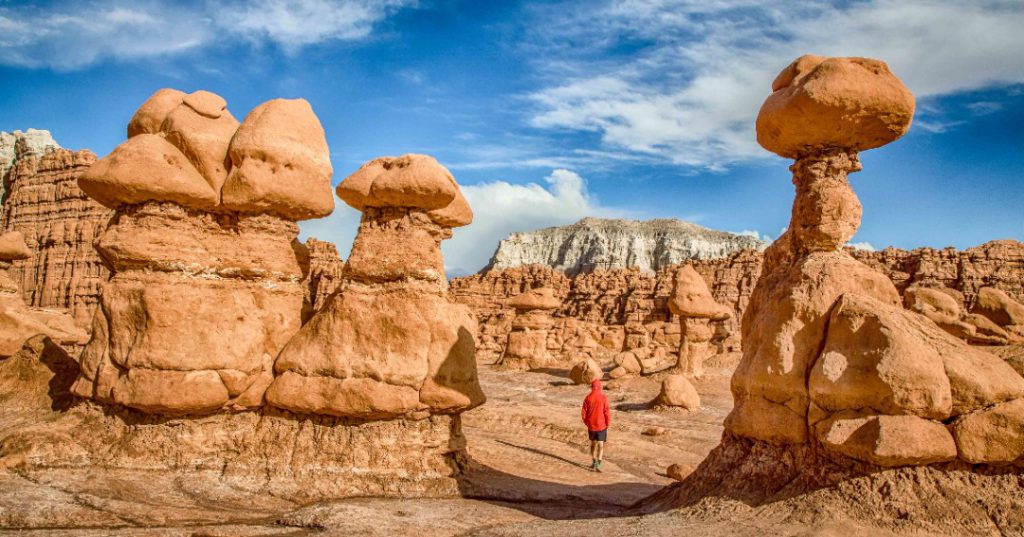
Hike among sandstone goblins and gnomes in the unique and colorful landscape of Goblin Valley State Park. You can explore the park through the five miles of trails or wander off-trail through the maze of goblins and other rock formations. This desert spot, along with the Arches area, is best visited in the spring or fall to avoid the hottest of the summer temperatures.
Where to eat, drink and sleep
The park features a campground along with two yurts. Reservations are highly recommended, and you should make them well in advance. You can find additional options for lodging along with food in Hanksville, about 30 miles to the south.
Sixt Insider Tip
You’ll feel like you’re on another planet as you explore the exotic terrain of Goblin Valley State Park. That’s probably why the movie Galaxy Quest was filmed here! See if you can recognize any of the filming sites as you wander through the other-worldly landscape.
From Goblin Valley State Park to Salt Lake City (223 miles)
The next stop along this road trip is the last one: Salt Lake City. You’ll leave the state park area via US-24 E, briefly rejoin I-70, and then take US-6 W toward Salt Lake City for most of the way. You’ll pass through several towns along the way, including Provo, the home of Brigham Young University.
Salt Lake City
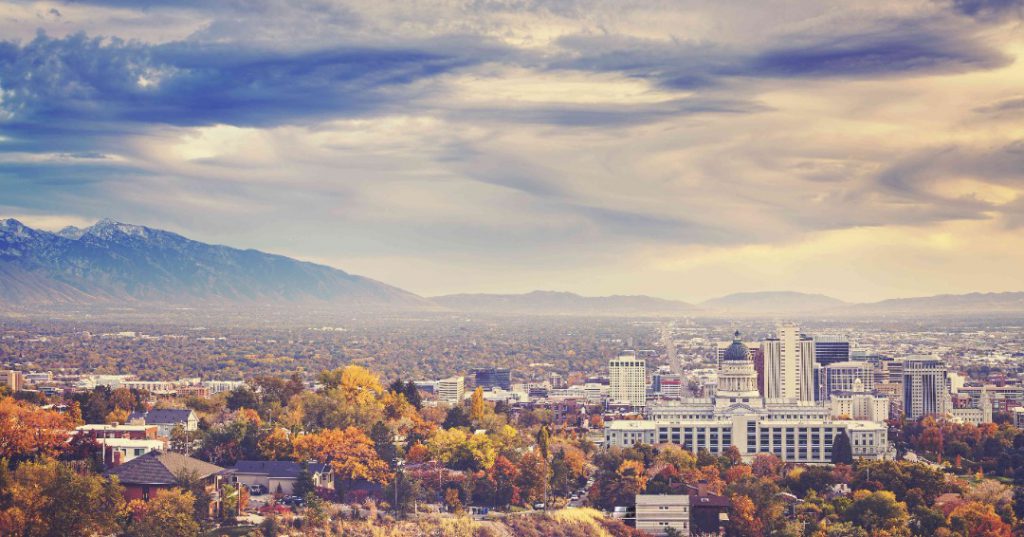
The Salt Lake City area offers the best of both cultural and natural sites. You’ll find art galleries, museums, nightlife and shopping along with plenty of opportunities for outdoor recreation. The Great Salt Lake itself offers multiple options for water activities, including swimming, floating, sailing and kayaking. Visit Antelope Valley State Park for easy access to the water from white sand beaches. You’ll also find hiking and biking trails on the island.
Points of interest
Plan a visit to the historic Temple Square, home of the Church of Jesus Christ of the Latter-day Saints. This 35-acre plaza features the impressive Salt Lake Temple, gardens, walking tours, and more. You also might want to check out the Family History Library, which is the world’s largest genealogy library. The world-famous Tabernacle Choir at Temple Square allows the public to attend their rehearsals in the Tabernacle for free on most Thursday nights.
Where to eat, drink and sleep
You’ll find lodging and dining options to meet any need and budget in Salt Lake City. For the most convenient location and access to the most popular sites, consider staying in the downtown area. If you’re looking for something a little different, the Sugar House neighborhood features nightlife, restaurants, bars and shopping with a hipster vibe.
Sixt Insider Tip
Utah Olympic Park is located just 25 miles from Salt Lake City, in Park City. You’ll find adventure activities of all kinds, including a summer bobsled, plus you can catch a Freestyle Show or check out the two free museums. Some activities are only available during the summer, so check the schedule before you go.